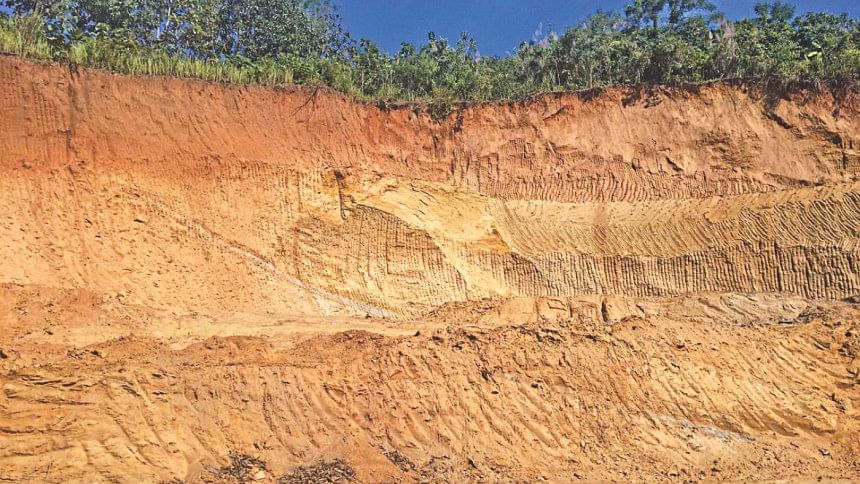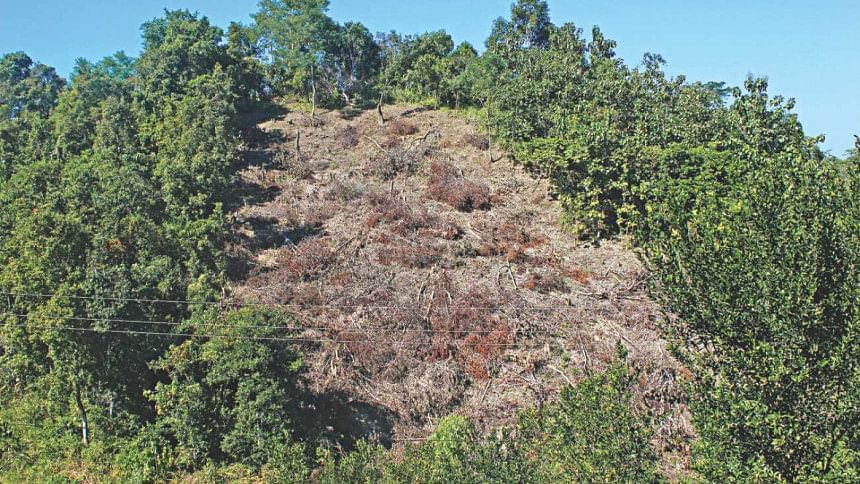Nobody to blame for the landslides

Photos: Rongrung Chakma
As the landslides wreaked havoc over Chittagong division in the last two weeks, there was one thing that everyone was at a consensus about – this was a man-made disaster.
Years of news reports, legal notices, and research papers on hill-cutting and deforestation all point to one thing. The losses might not have been so catastrophic if only there was better governance.
Take Cox's Bazar district. Mohammad Selim and his 3-year-old daughter Tishu Moni were killed in a landslide near Teknaf last week. This very district is currently pursuing approximately 150 lawsuits against hill-cutters. Sardar Shariful Islam, the assistant director of the Cox's Bazar Department of Environment (DoE), cites that number.
"These cases were filed since 2012, and it's not just the labourers who are being sued. For every incident of illegal earthmoving that came to our notice, we try to include the owner of the land in the lawsuit," says Islam. "There were also cases of hill-cutting on government property, in which case we try to get the land-grabbers convicted."
'Try' is the operative word here. With the department being run only by three people—including Islam himself—the number of cases they have so far completed is a grand total of zero.
"We have finished the investigation of only 25 cases I'd say. We are now waiting for hearing dates," Islam adds, resignedly.
Following a 2012 writ petition by Bangladesh Environmental Lawyers' Association (BELA), the Supreme Court directed that steps be taken to ensure that mountain-moving does not happen without environmental clearance. The DoE assistant director Islam's experience shows that hill-cutters are routinely making a mockery of the directive with no repercussions.
Added to that is the fact that up until a year or so back, no local inspector could sue hill-cutters without divisional clearance from the top bosses, according to Islam.

"No independent lawyer or legal association can file a lawsuit under the environment law on behalf of victims," says Manzill Murshid, the president of Human Rights and Peace for Bangladesh, an organisation that filed several cases against hill-cutting. "We can only file cases referring to section 102 of the Constitution." A case under section 102 simply calls on the court's power to intervene and order that a certain hill-cutting be stopped.
"We cannot sue perpetrators to punish them or stop them from repeating the act again," argues Murshid. The lawyer can only file petitions urging action to be taken.
His frustrations cannot ring more true in a context where hundreds of cases filed by the short-staffed DoE inspectors are yet to start investigation. Murshid argues that independent lawyers with better resources should be allowed to file lawsuits.
In 2014, when Murshid petitioned that the Chittagong Development Authority stop flattening the hill beneath the mayor's residence, the court did everything in its power to stop it—the fullest extent of which was ordering them to get an environmental clearance. They started cutting the hill again in 2016.
The challenges of getting an environmental clearance—is in itself a matter of debate. The districts of Cox's Bazar, Rangamati, Bandarban and Khagrachhari are yet to be mapped out to demarcate how land can be used in different zones, claims the DoE assistant director Shariful Islam.
To draw a parallel, Dhaka is meant to be governed by the Detailed Area Plan (DAP), which establishes what can be where, within the city (although this plan too has its criticisms).
"City planners in the district level are yet to design anything like that," says Islam. This opens up the field to alternative interpretations of which projects can get clearance or not.
Deciding whether something is an environmental threat can become very ambiguous when it comes to issues like deforestation. Not all deforestation projects are as severe as turning an area into a desert overnight, but are still harmful.
A Chittagong University assistant professor, Biswajit Nath's 2014 research in Bandarban shows that while the forest cover might look green from an aerial view, deforestation is definitely happening. He focused on the areas surrounding the Matamuhuri river and analysed it from 1981 to 2010 and published it in the Journal of Geosciences and Geomatics.
"Areas with dense vegetation have decreased," says Nath, now a doctoral fellow at the Chinese Academy of Sciences. From making up 46.34 percent of the area in 2001, the portion of lands with dense vegetation had gone down to 18.13 percent in 2010. More clear-cut deforestation was also happening by 2010; there was literally no area minus vegetation in 2001, which jumped to 20 percent of the area 10 years later.
An analysis like this is important because it puts into perspective deforestation techniques like transplanting dense woods with tobacco plantations—still green, but just not the right type. "Tobacco cultivation happens on the downward slope leading into the Matamuhuri river. Mass-scale agriculture in places like that can lead to soil erosion and silt up the river," says Nath, speaking from his experience working in the area. Soil erosion leads to mudslides and ultimately dangerous landslides.
The one thing that these laws do not take into cognizance is that these are the very activities which lead to the loss of human lives. Even if an occasional case does go through, the penalty is laughably insignificant. The penalty for earthmoving is only a maximum of Tk 2 lakh fine and two years of jail if the person is a first-time offender.
For repeat offenders, however, the penalty is Tk 10 lakh maximum, and a prison stow-away for 10 years, but there is a catch. The Cox's Bazar DoE for example has yet to bring a single offender to court—when the first case has not been proved yet, how do you identify repeat offenders?
The challenges of tackling landslides are numerous, starting from the failure of the local government and an overburdened legal system, to corrupt politics and greedy businesses. The question that remains is this, for how many more years shall we count the dead?

 For all latest news, follow The Daily Star's Google News channel.
For all latest news, follow The Daily Star's Google News channel. 








Comments